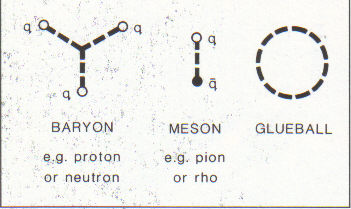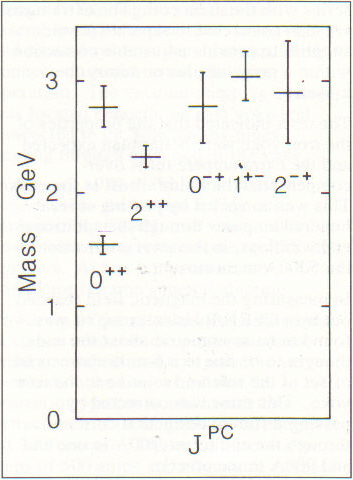

The force that holds protons and neutrons together is mediated by gluons. These gluons can stick to each other to give particles called glueballs. Using appropriate algorithms and supercomputing power, the properties of these glueballs can be calculated from first principles. Results from the Cray XMP/48 computer suggest that this is now feasible and the energy spectrum has been studied, write Professor Christopher Michael of Liverpool University and Dr Michael Teper of Oxford University.
The proton and neutron are the dominant constituents of the matter around us as they are the main particles in the atomic nucleus. They are themselves made up of other particles (such as quarks and pions) and the theory of Quantum Chromodynamics (QCD) provides a detailed description of their structure and of the strong forces holding them together. This can be pictured (figure I) as gluonic forces binding quarks. These same gluonic forces are also responsible for holding mesons (the pion, rho and so on) together.
The theory of QCD is formally rather similar to the theory of electric and magnetic forces and the gluon plays the role of mediating the strong force analogous to that of the photon in mediating the electromagnetic forces. The new feature in QCD is that the gluon can interact with itself: theoretically it is possible to have particles made purely out of gluons. These glueballs have been much discussed over the last decade. Experimental searches for them have been conducted, but it is always difficult to distinguish unambiguously between a glueball and an ordinary meson. Since QCD is a complete theory of quarks and gluons, another way forward is to calculate from first principles the glueball properties. This is now feasible using supercomputers.

Quantum Chromodynamics is a relativistic quantum field theory of quarks and gluons and it has no free parameters. A method to calculate properties of mesons and nucleons has been suggested, involving approximating space-time as a set of discrete points and studying a finite region in space and time. The theory then has a finite number of degrees of freedom and, formally at least, results can be obtained by integrating over these degrees of freedom. A reasonable study requires around 20 sites in each of the four space-time dimensions and, taking into account the variables needed to describe the gluonic fields, this implies around 5 million variables to describe a single arrangement of the fields in such a region of space-time. A 5-million dimensional integration is therefore needed to average over all possible configurations.
It is possible to approximate such an average by suitably selecting samples in a random way. This is only realistic if the quantity being averaged is always positive and this can be arranged by using 'imaginary time'. Theoretically this is well defined, but it is hard to explain other than as a mathematical trick which converts quantum field theory into statistical mechanics: one can then use what is known as a Monte Carlo simulation, for which efficient algorithms have been developed. Even with such algorithms, massive computational effort is needed to update each variable successively and obtain a sequence of statistically independent samples of the gluonic fields. Much as in an experiment, these samples are 'data' and one can then measure correlations of appropriate quantities in these samples to get results for the mass values of states.
A major technical breakthrough in our work has been in choosing carefully the quantities to measure so as to get accurate values of the masses of the low lying states - a so-called fuzzing algorithm is the key advance.
The authors combined ideas and Cray time allocations to make an assault on the glueball spectrum using these methods. The program was fully vectorised, the solid state disk was heavily used because of the large number of variables needed to describe the system and over 1000 hours were used. Compared to earlier work we were able to simulate relatively large volumes (about 1.5 femtometres across) with sufficiently small lattice step length (about 0.07 fm) to get results which were independent of the lattice 'superstructure'. In particular we obtained strong evidence that the lightest glueball was scalar (spin J = 0, parity P even, charge conjugation C even, referred to as Jpc of 0++) rather than tensor (2++) as had been claimed in lattice work from groups in Florida using a Cyber 205 and in Rome using a dedicated purpose-built supercomputer (APE). Subsequent results by other groups have supported our work.

The spectrum we find is illustrated in figure 2. These theoretical calculations are in 'pure-gauge' QCD with no quarks present. Nature has quark effects included and so a direct comparison with experiment is not possible: glueballs and mesons get mixed. One exception is for spin-exotic glueballs such as 1 + or 2+ for which there are no quark-antiquark mesons at all; these are known as 'oddballs'. We find no evidence for light oddball states (contradicting some earlier tentative work) which is rather discouraging from the point of view of an experimentalist wishing to observe glueballs unambiguously. It is possible to include quark effects in the lattice approach which would clarify comparison with accelerator experiments. This is currently under study but appears to need enormous computational resources of the order of 100 times those used for the work reported here.